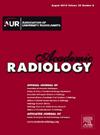Imaging the Future: Student Reflections on an Innovative Undergraduate Radiology Course
IF 3.9
2区 医学
Q1 RADIOLOGY, NUCLEAR MEDICINE & MEDICAL IMAGING
引用次数: 0
Abstract
Rationale and Objectives
Radiology plays a critical role in modern healthcare, yet it is often underrepresented in undergraduate education. To address this gap, the University of British Columbia (UBC) introduced RADS 301: exploring imaging in the 21st century, the first undergraduate radiology course of its kind in Canada. This study aims to examine the demographic backgrounds, motivations, and course evaluations of students enrolled in RADS 301.
Methods
An anonymous end-of-course survey was administered to students enrolled in RADS 301 during the 2024 academic term. The survey included demographic questions, multiple-choice and Likert-scale items evaluating various aspects of the course, and an open-ended feedback section. Descriptive statistics were used to analyze categorical and ordinal data, while qualitative responses were thematically reviewed.
Results
Out of 187 enrolled students, 178 (95%) completed the survey. Students represented a diverse range of academic disciplines, with just over half (55%) enrolled in Health and Life Science majors and the remainder from a variety of other fields, including humanities, business, and arts. Primary motivations for taking the course included general interest in medical topics (78%) and career exploration in healthcare (52%). Course evaluations demonstrated high satisfaction across all domains, with mean ratings ranging from 4.51 (SD = 0.60) to 4.70 (SD = 0.51) on a five-point scale. The overall course rating was 4.76 (SD = 0.45). Qualitative responses emphasized the engaging content, diverse instructors, impact on career clarity, and improvements in health literacy.
Conclusion
RADS 301 is a promising model for early exposure to radiology and interdisciplinary healthcare education at the undergraduate level. The course was well-received by students from a wide array of backgrounds and appears to enhance interest, knowledge, and confidence in radiology. Findings support the expansion of similar undergraduate courses to foster informed career exploration and promote health literacy.
想象未来:学生对创新本科放射学课程的思考。
基本原理和目标:放射学在现代医疗保健中起着至关重要的作用,但在本科教育中往往代表性不足。为了解决这一差距,不列颠哥伦比亚大学(UBC)推出了RADS 301:探索21世纪的成像,这是加拿大首个本科放射学课程。本研究旨在调查选修RADS 301的学生的人口背景、动机和课程评价。方法:对2024学年RADS 301的在校生进行匿名期末调查。这项调查包括人口统计问题、多项选择题和李克特量表,评估课程的各个方面,以及一个开放式的反馈部分。描述性统计用于分析分类和顺序数据,而定性反应是专题审查。结果:187名在校生中,有178名(95%)完成了调查。学生来自不同的学科,超过一半(55%)的学生就读于健康和生命科学专业,其余的学生来自其他领域,包括人文、商业和艺术。参加该课程的主要动机包括对医学主题的一般兴趣(78%)和对医疗保健的职业探索(52%)。课程评估在所有领域都显示出很高的满意度,在五分制中平均评分从4.51 (SD = 0.60)到4.70 (SD = 0.51)不等。整个疗程评分为4.76 (SD=0.45)。定性回答强调了引人入胜的内容、多样化的教师、对职业清晰度的影响以及健康素养的提高。结论:RADS 301在本科阶段放射学早期接触和跨学科卫生教育中具有良好的应用前景。该课程受到来自各种背景的学生的欢迎,似乎增强了他们对放射学的兴趣、知识和信心。研究结果支持扩大类似的本科课程,以促进知情的职业探索和促进健康素养。
本文章由计算机程序翻译,如有差异,请以英文原文为准。
求助全文
约1分钟内获得全文
求助全文
来源期刊

Academic Radiology
医学-核医学
CiteScore
7.60
自引率
10.40%
发文量
432
审稿时长
18 days
期刊介绍:
Academic Radiology publishes original reports of clinical and laboratory investigations in diagnostic imaging, the diagnostic use of radioactive isotopes, computed tomography, positron emission tomography, magnetic resonance imaging, ultrasound, digital subtraction angiography, image-guided interventions and related techniques. It also includes brief technical reports describing original observations, techniques, and instrumental developments; state-of-the-art reports on clinical issues, new technology and other topics of current medical importance; meta-analyses; scientific studies and opinions on radiologic education; and letters to the Editor.
 求助内容:
求助内容: 应助结果提醒方式:
应助结果提醒方式:


